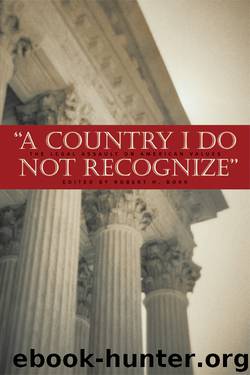A Country I Do Not Recognize by Robert H. Bork

Author:Robert H. Bork
Language: eng
Format: epub
Publisher: Hoover Institution Press
— 3 —
A Court Tilting against Religious Liberty
Terry Eastland
The First Amendment provides in part, “Congress shall make no law respecting an establishment of religion or prohibiting the free exercise thereof.” The amendment became part of the Constitution in 1791, but not until 1940, in Cantwell v. Connecticut, did the Supreme Court declare that the states are “as incompetent as Congress to enact” laws establishing religion or prohibiting its free exercise.1 Citing the Fourteenth Amendment’s provision that no state may deprive a person of liberty without due process of law, the Court held that “this fundamental concept of liberty . . . embraces the liberties guaranteed by the First Amendment.” Before Cantwell, the states had passed plenty of laws touching on religion—far more than Congress. Cantwell meant that state laws involving religion could be challenged under the First Amendment. With the necessary plaintiffs quickly emerging, the Court has now decided a long list of cases concerning a wide range of issues, most of them arising from the states.
The Court’s religion jurisprudence is almost entirely a product of the cases since Cantwell. Legal scholars agree that it is an intellectual mess. Unfortunately, that is not the worst that can be said about it. The truth is that the Court’s religion decisions have done serious damage to the country.
Religious liberty is a core American value. Indeed, some scholars call it our “first liberty.” The purpose of the treatment of religion in the First Amendment was to protect religious liberty. Yet rather than understanding the First Amendment as containing a single clause with that purpose, the Court has persisted in finding two religion clauses in the amendment—the establishment clause and the free exercise clause—and in reading them independently of one another. Through the establishment clause the Court has insisted on a stricter “separation of church and state” than the original intent of the First Amendment demands. The Court has used the clause to push religion from the public schools and to inhibit efforts to provide public aid for church-related schools. Meanwhile, the Court has had little to say about “free exercise” and in recent years has treated it as a subset of free speech, lacking any independent value. Thanks to the Court, Americans are not as free to exercise religion as the Constitution, properly interpreted, allows.
The Court is a major reason that the country today is far more secular than the one a dwindling number of Americans grew up in. The secularizing influence of the Court’s decisions can be seen in many areas, not least our public schools.
Download
This site does not store any files on its server. We only index and link to content provided by other sites. Please contact the content providers to delete copyright contents if any and email us, we'll remove relevant links or contents immediately.
Day by Elie Wiesel(2596)
The Age of Genius by A. C. Grayling(2393)
Gideon's Spies: The Secret History of the Mossad by Gordon Thomas(2238)
The Gulag Archipelago (Vintage Classics) by Aleksandr Solzhenitsyn(1987)
FATWA: Hunted in America by Pamela Geller(1927)
Columbine by Dave Cullen(1767)
Men Explain Things to Me by Rebecca Solnit(1607)
The Rule of Law by Bingham Tom(1594)
Examples & Explanations: Administrative Law by William F. Funk & Richard H. Seamon(1552)
Anatomy of Injustice by Raymond Bonner(1532)
Three Cups of Tea by Greg Mortenson(1518)
That Every Man Be Armed by Stephen P. Halbrook(1480)
ADHD on Trial by Michael Gordon(1474)
The Source by James A. Michener(1459)
Gideon's Spies by Gordon Thomas(1425)
Future Design by Unknown(1386)
Palestinian Walks by Raja Shehadeh(1363)
Constitutional Theory by Carl Schmitt(1347)
Fast Times in Palestine by Pamela Olson(1335)
